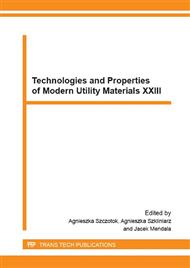[1]
Y.H. Zhu, J. Islas, Microstructures and dimensional stability of extruded eutectoid Zn-Al alloy, J. Mater. Process. Tech. 66 (1997) 244-248.
DOI: 10.1016/s0924-0136(96)02532-0
Google Scholar
[2]
H. Kania, The Structure of Coatings Obtained in the Zn-31Al-3Mg Bath on High-Silicon Steel, Proc. of XXI Conference TPMUM 2013, Solid State Phenom. 212 (2014) 101-106.
DOI: 10.4028/www.scientific.net/ssp.212.101
Google Scholar
[3]
J. Mendala, Influence of the cooling method on the structure of 55AlZn coatings, IOP Conference Series – Mater. Sci. Eng. Vol. 22, 012004, (2011).
DOI: 10.1088/1757-899x/22/1/012004
Google Scholar
[4]
H. Kania, M. Bierońska, Corrosion Resistance of Zn-31AlMg Coatings Obtained by Batch Hot Dip Method, Solid State Phenom. 212 (2014) 167-172.
DOI: 10.4028/www.scientific.net/ssp.212.167
Google Scholar
[5]
J. Mendala, Liquid metal embrittlement of steel with galvanized coatings, IOP Conference Series – Mater. Sci. Eng. Vol. 35, 012002, (2012).
DOI: 10.1088/1757-899x/35/1/012002
Google Scholar
[6]
T. Savaskan, M. Aydm, Fatigue behaviour of monotectoid-based Zn-Al-Cu alloys in 3. 5 % NaCl and 1 % HCl solutions, Mater. Charact. 52 (2004) 269-278.
DOI: 10.1016/j.matchar.2004.05.008
Google Scholar
[7]
P. Liberski, P. Podolski, H. Kania, A. Gierek, J. Mendala, Corrosion resistance of zinc coatings obtained in high-temperature baths, Mater. Sci+ 39, 5 (2003) 652-657.
DOI: 10.1023/b:masc.0000023504.84007.42
Google Scholar
[8]
H. Kania, The structure of coatings obtained in a ZnAl23Si bath by the batch hot dip method, Solid State Phenom. 226 (2015) 155-160.
DOI: 10.4028/www.scientific.net/ssp.226.155
Google Scholar
[9]
J. Mendala, The influence of Si addition in 55AlZn bath on the coating structures obtained in the batch hot-dip metallization, IOP Conference Series – Mater. Sci. Eng. Vol. 22, 012005, (2011).
DOI: 10.1088/1757-899x/22/1/012005
Google Scholar
[10]
Z. Azkali, T. Savaskan, An examination of friction and sliding wear properties of Zn-40Al-2Cu-2Si alloy in case of oil cut off, Tribol. Int. 41 (2008) 9-16.
DOI: 10.1016/j.triboint.2007.04.002
Google Scholar
[11]
B. Prasad, Influence of heat treatment parameters on the lubricated sliding wear behaviour of a zinc-based alloy, Wear 257 (2004) 1137-44.
DOI: 10.1016/j.wear.2004.07.006
Google Scholar


